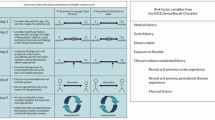Abstract
Data sources Six electronic databases/registries including MEDLINE, Cochrane Central Register of Controlled Trials (CENTRAL), LILACS, Embase, SCOPUS, Web of Science) were searched up to 1 January 2018. Additionally, ongoing and unpublished trials were sought as well as a manual search also to January 2018. No restrictions on language or publication date were set.
Study selection Only randomised controlled trials (RCTs) assessing active orthodontic patients that received any type of reminder or not, and the impact of the reminder on periodontal parameters and/or rate of attendance, were included.
Data extraction and synthesis Two reviewers abstracted data independently after a customised data extraction form was piloted. Risk of bias (RoB) was assessed using the Cochrane collaboration risk of bias tool. The results for periodontal parameters were synthesised (random effects meta-analysis) as mean difference or standardised mean difference with 95% CIs. Effects on attendance rate and frequency of white spots were synthesised (random effects meta-analysis) using relative risks (RR) with their 95% CIs where possible.
Results Fourteen parallel-group RCTs involving 2,078 participants were included with 1,059 participants in the meta-analysis). Studies in different parts of the world were included. Different reminder systems were identified (SMS, mail, automatic phone calls, mobile apps). Outcomes considered were: plaque scores (ten RCTs), gingival scores (six RCTs), appointment attendance (five RCTs), white spot development (four RCTs), and other outcomes (one RCT). Three studies were judged at high RoB, six were unclear and five were at low RoB (not included in the meta-analysis). Plaque indices measured over a short time period were significantly affected (SMD .38; 95%CI: -0.65 to -0.10), and over longer term .Patients receiving reminders (SMD -1.51; 95%CI: -2.72 to -0.30)were less likely to miss appointments (RR 0.39; 95%CI: 0.22 to 0.70) or develop white spots (RR 0.45; 95%CI: 0.31 to 0.65) .
Conclusions In general terms there is moderate-to-high quality of evidence that reminders have a positive effect on oral hygiene, improved appointment adherence and the reduction of white spot development.
Similar content being viewed by others
A Commentary on
Mohammed H, Rizk M Z, Wafaie K, Ulhaq A, Almuzian M.
Reminders improve oral hygiene and adherence to appointments in orthodontic patients: a systematic review and meta-analysis. Eur J Orthod 2019; 41: 204-213. DOI: 10.1093/ejo/cjy045. PubMed PMID: 29947755.
Commentary
It is difficult to translate the identified differences in oral hygiene in terms of practice, as they are reported as SMD (standardised mean difference). What exactly does a reduction of 0.38 (short-term) or 1.51 (long-term) SMD mean in terms of impact on the patient? In real life a plaque index such as the Silness-Low scale is used, with scores of either 0, 1, 2, or 3. A change of less than half a point in SMD over the short-term is likely to be clinically meaningless. Long-term (>3 months) a meaningful change would be at least one point in the scale and in some patients up to two points. In a five-point scale, the change is relatively less important and so on. Additionally, there was large variability between patients (around 80% of the mean change) so the individual response is unpredictable (varying from clinically unimportant to probably clinically important).
With regards to the improvement in appointment adherence and reduction in white spots, those changes are more clearly clinically meaningful (39% and 46% reduction in risk, respectively). Again the large variability has to be noted (around 50%). So, although changes in individual patients are difficult to predict, both effects are clinically meaningful and should encourage the use of reminder systems.
Overall this is well-conducted systematic review (SR). It is up-to-date (January 2018) and has followed generally accepted principles for conducting a SR with meta-analysis. Some minor areas for improvement could have been considered. Maybe their wording as 'quality of evidence' in the conclusions should have been 'certainty of evidence' to better match the GRADE interpretation? Maybe a better wording for 'long-term' would have been 'medium-term' as the data considered in this category was mostly collected three to six months into treatment. Only two studies followed their samples during all the treatment. It also has to be noted that the supplementary material considers some useful subgroup analysis. Some may actually be considered more important or clinically relevant than those included in the PDF version of the article. Finally, the positive impact on white spot development is not noted in the conclusion section.
Author information
Authors and Affiliations
Rights and permissions
About this article
Cite this article
Mir, C. Among orthodontic patients, does the use of reminder systems compared to no reminders improve periodontal parameters and appointment adherence?. Evid Based Dent 20, 94 (2019). https://doi.org/10.1038/s41432-019-0045-2
Published:
Issue Date:
DOI: https://doi.org/10.1038/s41432-019-0045-2



